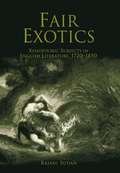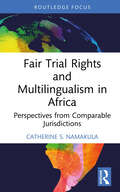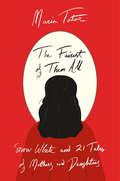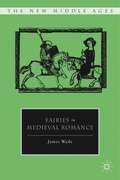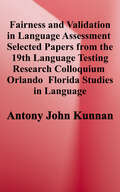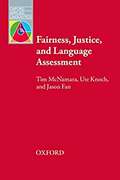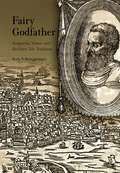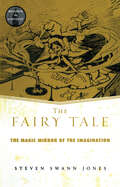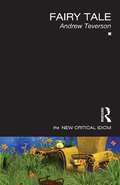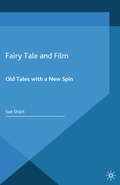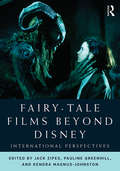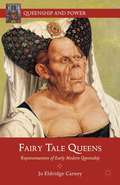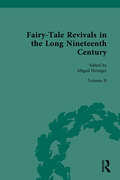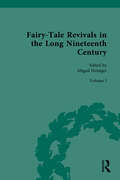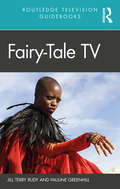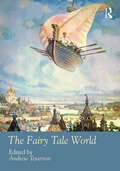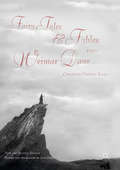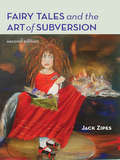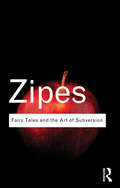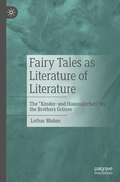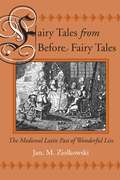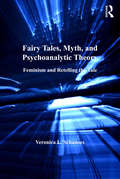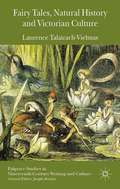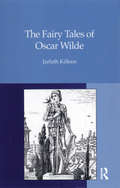- Table View
- List View
Fair Exotics: Xenophobic Subjects in English Literature, 1720-1850 (New Cultural Studies)
by Rajani SudanArguing that the major hallmarks of Romantic literature—inwardness, emphasis on subjectivity, the individual authorship of selves and texts—were forged during the Enlightenment, Rajani Sudan traces the connections between literary sensibility and British encounters with those persons, ideas, and territories that lay uneasily beyond the national border. The urge to colonize and discover embraced both an interest in foreign "fair exotics" and a deeply rooted sense of their otherness.Fair Exotics develops a revisionist reading of the period of the British Enlightenment and Romanticism, an age during which England was most aggressively building its empire. By looking at canonical texts, including Defoe's Robinson Crusoe, Johnson's Dictionary, De Quincey's Confessions of an English Opium Eater, and Bronte's Villette, Sudan shows how the imaginative subject is based on a sense of exoticism created by a pervasive fear of what is foreign. Indeed, as Sudan clarifies, xenophobia is the underpinning not only of nationalism and imperialism but of Romantic subjectivity as well.
Fair Trial Rights and Multilingualism in Africa: Perspectives from Comparable Jurisdictions (Law, Language and Communication)
by Catherine S. NamakulaThis book examines the best language fair trial practices of the courts in arguably the most multilingual region of the world. It contains an instructive list of standards and approaches to linguistic dynamics, which may be considered a language fair trial rights code. By way of jurisprudential analysis and scrutiny of constitutional imperatives and examination of legislation among the respective jurisdictions from the Sahel region, to the Horn of Africa, and the Cape, this publication presents peculiar country-specific practices and common standards aiming towards the realisation of a fair trial in a multilingual context. The exceptionally multilingual nature of legal processes in Africa makes the standards in the region instructive in the progression towards a universal language fair trial rights code. The book reveals valuable lessons across jurisdictions, including those outside Africa, and suggests measures that may be taken to improve existing approaches. It will be a valuable resource for academics, researchers, and policy-makers working in the areas of Law and Language, Legal Linguistics, Forensic Linguistics, Criminal Justice, and Comparative Law.
The Fairest of Them All: Snow White and 21 Tales of Mothers and Daughters
by Maria TatarWe think we know the story of Snow White from Disney and the Brothers Grimm. But acclaimed folklorist Maria Tatar reveals dazzling variations from across the globe. The story of the rivalry between a beautiful, innocent girl and her equally beautiful and cruel mother has been endlessly repeated and refashioned all over the world. In Switzerland you might hear about seven dwarfs who shelter a girl, only to be murdered by robbers. In Armenia a mother orders her husband to kill his daughter because the moon has declared her “the most beautiful of all.” The Brothers Grimm gave this story the name by which we know it best, and in 1937 Walt Disney sweetened their somber version to make the first feature-length, animated fairy tale, Snow White and the Seven Dwarfs. Since then the Disney film has become our cultural touchstone—the innocent heroine, her evil stepmother, the envy that divides them, and a romantic rescue from domestic drudgery and maternal persecution. But, as every fan of the story knows, there is more to Snow White than that. The magic mirror, the poisoned apple, the catatonic sleep, and the strange scene of revivification are important elements in the phantasmagoria of the Snow White universe. Maria Tatar, an acclaimed folklorist and translator, brings to life a global melodrama of mother-daughter rivalries that play out across countries and cultures.
Fairies in Medieval Romance
by James WadeThis is the first book to construct a theoretical framework that not only introduces a new way of reading romance writing at large, but more specifically that generates useful critical readings of the specific functions of fairies in individual romance texts.
Fairness and Validation in Language Assessment: Selected papers from the 19th Language Testing Research Colloquium, Orlando, Florida (Studies in Language Testing #9)
by Antony John KunnanFairness of language tests and testing practices has always been a concern among test developers and test users. In the past decade educational and language assessment researchers have begun to focus directly on fairness and related matters such as test standards, test bias and equity and ethics for testing professionals. <p><p>The 19th annual Language Testing Research Colloquium held in 1997 in Orlando, Florida, brought this overall concern into sharp focus by having 'Fairness in Language Testing' as its theme. The conference presentations and discussions attempted to understand the concept of fairness, define the scope of the concept and connect it with the concept of validation of test score interpretation. The papers in this volume offer a first introduction to fairness and validation in the field of language assessment.
Fairness, Justice, and Language Assessment
by Tim McNamara Ute Knoch Jason Fan Oxford EditorsThis book has two goals, each related to the validity of language assessment. The first goal is to explore the difference between fairness and justice in language assessment. <p><p> The authors distinguish internal and external dimensions of the equitable and just treatment of individuals taking language tests which are used as gatekeeping devices to determine access to education and employment, immigrant status, citizenship, and other rights. <p><p> The second goal is to show how the extent of test fairness can be demonstrated and improved using the tools of psychometrics, in particular the models collectively known as Rasch measurement.
Fairy Godfather
by Ruth B. BottigheimerIn the classic rags-to-riches fairy tale a penniless heroine (or hero), with some magic help, marries a royal prince (or princess) and rises to wealth. Received opinion has long been that stories like these originated among peasants, who passed them along by word of mouth from one place to another over the course of centuries. In a bold departure from conventional fairy tale scholarship, Ruth B. Bottigheimer asserts that city life and a single individual played a central role in the creation and transmission of many of these familiar tales. According to her, a provincial boy, Zoan Francesco Straparola, went to Venice to seek his fortune and found it by inventing the modern fairy tale, including the long beloved Puss in Boots, and by selling its many versions to the hopeful inhabitants of that colorful and commercially bustling city.With innovative literary sleuthing, Bottigheimer has reconstructed the actual composition of Straparola's collection of tales. Grounding her work in social history of the Renaissance Venice, Bottigheimer has created a possible biography for Straparola, a man about whom hardly anything is known. This is the first book-length study of Straparola in any language.
The Fairy Tale (Genres in Context)
by Steven Swann JonesOne of the best known and enduring genres, the fairy fales origins extend back to the preliterate oral societies of the ancient world. This books surveys its history and traces its evolution into the form we recognized today. Jones Builds on the work of folklorist and critics to provide the student with a stunning, lucid overview of the genre and a solid understanding of its structure.
Fairy Tale (The New Critical Idiom)
by Andrew TeversonThis volume offers a comprehensive critical and theoretical introduction to the genre of the fairy tale. It: explores the ways in which folklorists have defined the genre assesses the various methodologies used in the analysis and interpretation of fairy tale provides a detailed account of the historical development of the fairy tale as a literary form engages with the major ideological controversies that have shaped critical and creative approaches to fairy tales in the twentieth and twenty-first centuries demonstrates that the fairy tale is a highly metamorphic genre that has flourished in diverse media, including oral tradition, literature, film, and the visual arts.
Fairy Tale and Film: Old Tales with a New Spin
by S. ShortSue Short examines how fairy tale tropes have been reworked in contemporary film, identifying familiar themes in a range of genres – including rom coms, crime films and horror – and noting key similarities and differences between the source narratives and their offspring.
Fairy-Tale Films Beyond Disney: International Perspectives
by Jack Zipes Pauline Greenhill Kendra Magnus-JohnstonThe fairy tale has become one of the dominant cultural forms and genres internationally, thanks in large part to its many manifestations on screen. Yet the history and relevance of the fairy-tale film have largely been neglected. In this follow-up to Jack Zipes’s award-winning book The Enchanted Screen (2011), Fairy-Tale Films Beyond Disney offers the first book-length multinational, multidisciplinary exploration of fairy-tale cinema. Bringing together twenty-three of the world’s top fairy-tale scholars to analyze the enormous scope of these films, Zipes and colleagues Pauline Greenhill and Kendra Magnus-Johnston present perspectives on film from every part of the globe, from Hayao Miyazaki’s Spirited Away, to Jan Švankmajer’s Alice, to the transnational adaptations of 1001 Nights and Hans Christian Andersen. Contributors explore filmic traditions in each area not only from their different cultural backgrounds, but from a range of academic fields, including criminal justice studies, education, film studies, folkloristics, gender studies, and literary studies. Fairy-Tale Films Beyond Disney offers readers an opportunity to explore the intersections, disparities, historical and national contexts of its subject, and to further appreciate what has become an undeniably global phenomenon.
Fairy Tale Queens
by Jo Eldridge CarneyMost of today's familiar fairy tales come from the stories of Charles Perrault, the Brothers Grimm, and Hans Christian Andersen, but this innovative study encourages us to explore the marvelous tales of authors from the early modern period Giovanni Straparola, Giambattista Basile, Madame Marie-Catherine D'Aulnoy, and others whose works enrich and expand the canon. As author Jo Eldridge Carney shows, the queen is omnipresent in these stories, as much a hallmark of the genre as other familiar characteristics such as the number three, magical objects, and happy endings. That queens occupy such space in early modern tales is not surprising given the profound influence of so many powerful queens in the political landscapes of early modern England and Europe. Carney makes a powerful argument for the historical relevance of fairy tales and, by exploring the dynamic intersection between fictional and actual queens, shows how history and folk literature mutually enrich our understanding of the period.
Fairy-Tale Revivals in the Long Nineteenth Century: Volume II: Fairy- Tale Revival Dramas: Writing Wonder in Transatlantic Ethnic Literary Revivals, 1850–1950
by Abigail HeinigerVolume two explores the way a wide range of classic princess tales written by marginalized writers. Rapunzel and Snow White, with their pale skin or long ropes of golden hair, are particularly popular vehicles for exploring and challenging racialized constructions of beauty. Marriage is the traditional vehicle of a happy ending in Princess tales, so marginalized responses to these tales also inherently respond to the doubly colonized position of women in the Anglophone world. The institution of marriage typically exposes the institutional oppression of colonized women. Authors include Charles Chesnutt, Jessie Fauset, Julia Kavanaugh, George Edwards, some of the unpublished manuscripts of Jewish-Australian author Joseph Jacobs, and the earliest work of Sinèad de Valera, as well as fin-de-siècle illustrators such as Harry Clarke, and collected oral tales.
Fairy-Tale Revivals in the Long Nineteenth Century: Volume I: Fairy-Tale Revivals: Writing Wonder in Transatlantic Ethnic Literary Revivals, 1850–1950
by Abigail HeinigerThis collection opens with marginalized responses to the highly politicized Cinderella traditions in the Anglophone world. In the United States, Cinderella was incorporated into the gendered narrative of the American Dream and narratives of empire in the colonial world, particularly in the mid-1800s. Marginalized writers have responded to these nationalistic colonial traditions in two distinctive ways: clever Cinderellas who negotiate a broken system or passive Cinderellas who die as anti-heroes in disenchanting fairy tales. This dual tradition of marginalized Cinderellas is also apparent across the Anglophone world. Potential texts include the out-of-print works of Sinèad de Valera, excerpts from the novels of Hannah Crafts, Jessie Fauset, and Julia Kavanagh, along with dramas by Ann Devlin, and collected oral tales.
Fairy-Tale Science
by Suzanne MagnaniniBetween 1550 and 1650, Europe was swept by a fascination with wondrous accounts of monsters and other marvels - of valiant men slaying dragons, women giving birth to animals, young girls growing penises, and all manner of fantastic phenomena. Known as 'fairy tales,' these stories had many guises and inhabited a variety of literary texts. The first two collections of such fairy tales published on the continent, Giovan Francesco Straparola's Le piacevoli notti and Giambattista Basile's Lo cunto de li cunti, were greeted with much enthusiasm at home and abroad and essentially established a new literary genre. Contrary to popular thought, Italy, not Germany or France, was the birthplace of the literary fairy tale.This fascination with the marvellous also extended to the worlds of science, medicine, philosophy, and religion, and many treatises from the period focused on discussions of monsters, demons, magic, and witchcraft. In Fairy-Tale Science Suzanne Magnanini looks at these 'science fictions' and explores the birth and evolution of the literary fairy tale in the context of early modern discourses on the monstrous. She demonstrates how both the normative literary theories of the Italian intellectual establishment and the emerging New Science limited the genre's success on its native soil. Natural philosophers, physicians, and clergymen positioned the fairy tale in opposition in opposition to science, fixing it as a negative pole in a binary system, one which came to define both a new type of scientific inquiry and the nascent literary genre. Magnanini also suggests that, by identifying their literary production with the monstrous and the feminine, Straparola and Basile contributed to the marginalization of the new genre.A wide-ranging yet carefully crafted study, Fairy-Tale Science investigates the complex interplay between scientific discourse and an emerging literary genre, and expands our understanding of the early modern European imagination.
Fairy-Tale TV (Routledge Television Guidebooks)
by Jill Terry Rudy Pauline GreenhillThis concise and accessible critical introduction examines the world of popular fairy-tale television, tracing how fairy tales and their social and cultural implications manifest within series, television events, anthologies, and episodes, and as freestanding motifs. Providing a model of televisual analysis, Rudy and Greenhill emphasize that fairy-tale longevity in general, and particularly on TV, results from malleability—morphing from extremely complex narratives to the simple quotation of a name (like Cinderella) or phrase (like "happily ever after")—as well as its perennial value as a form that is good to think with. The global reach and popularity of fairy tales is reflected in the book’s selection of diverse examples from genres such as political, lifestyle, reality, and science fiction TV. With a select mediagraphy, discussion questions, and detailed bibliography for further study, this book is an ideal guide for students and scholars of television studies, popular culture, and media studies, as well as dedicated fairy-tale fans.
The Fairy Tale World (Routledge Worlds)
by Andrew TeversonThe Fairy Tale World is a definitive volume on this ever-evolving field. The book draws on recent critical attention, contesting romantic ideas about timeless tales of good and evil, and arguing that fairy tales are culturally astute narratives that reflect the historical and material circumstances of the societies in which they are produced. The Fairy Tale World takes a uniquely global perspective and broadens the international, cultural, and critical scope of fairy-tale studies. Throughout the five parts, the volume challenges the previously Eurocentric focus of fairy-tale studies, with contributors looking at: • the contrast between traditional, canonical fairy tales and more modern reinterpretations; • responses to the fairy tale around the world, including works from every continent; • applications of the fairy tale in diverse media, from oral tradition to the commercialized films of Hollywood and Bollywood; • debates concerning the global and local ownership of fairy tales, and the impact the digital age and an exponentially globalized world have on traditional narratives; • the fairy tale as told through art, dance, theatre, fan fiction, and film. This volume brings together a selection of the most respected voices in the field, offering ground-breaking analysis of the fairy tale in relation to ethnicity, colonialism, feminism, disability, sexuality, the environment, and class. An indispensable resource for students and scholars alike, The Fairy Tale World seeks to discover how such a traditional area of literature has remained so enduringly relevant in the modern world.
Fairy Tales and Fables from Weimar Days
by Jack ZipesThis book is a collection of traditional German fairy tales and fables, deliberately transformed into utopian narratives and social commentary by political activists in the Weimar Republic (1919-1933). Against a backdrop of financial and political instability, widespread homelessness, and the reformation of public institutions, numerous gifted writers such as Berta Lask, Kurt Schwitters, Hermynia zur Mühlen, Oskar Maria Graf, Bruno Schönlank, and Joachim Ringelnatz responded to the need for hope among the common people by creating fairy tales and fables that offered a new and critical vision of social conditions. Though many of their tales deal with the grim situation of common people and their apparent helplessness, they are founded on the principle of hope. This revised edition includes over 50 illustrations by contemporary international artists who reveal how similar the Weimar conditions were to the conditions in which we presently live. In this respect, the Weimar fairy tales and fables have not lost their spirit and significance.
Fairy Tales and the Art of Subversion: The Classical Genre For Children And The Process Of Civilization (Routledge Classics Ser.)
by Jack ZipesThe fairy tale may be one of the most important cultural and social influences on children's lives. But until Fairy Tales and the Art of Subversion, little attention had been paid to the ways in which the writers and collectors of tales used traditional forms and genres in order to shape children's lives – their behavior, values, and relationship to society. As Jack Zipes convincingly shows, fairy tales have always been a powerful discourse, capable of being used to shape or destabilize attitudes and behavior within culture.For this new edition, the author has revised the work throughout and added a new introduction bringing this classic title up to date.
Fairy Tales and the Art of Subversion: The Classical Genre For Children And The Process Of Civilization (Routledge Classics)
by Jack ZipesThe fairy tale is arguably one of the most important cultural and social influences on children's lives. But until the first publication of Fairy Tales and the Art of Subversion, little attention had been paid to the ways in which the writers and collectors of tales used traditional forms and genres in order to shape children's lives – their behavior, values, and relationship to society. As Jack Zipes convincingly shows in this classic work, fairy tales have always been a powerful discourse, capable of being used to shape or destabilize attitudes and behavior within culture. How and why did certain authors try to influence children or social images of children? How were fairy tales shaped by the changes in European society in the sixteenth and seventeenth centuries? Zipes examines famous writers of fairy tales such as Charles Perrault, Jacob and Wilhelm Grimm, Hans Christian Andersen and L.Frank Baum and considers the extraordinary impact of Walt Disney on the genre as a fairy tale filmmaker.
Fairy Tales as Literature of Literature: The "Kinder- und Hausmärchen" by the Brothers Grimm
by Lothar BluhmIn this study, the Brothers Grimm's fairy tales are consistently examined as literature out of literature. Through the history of their creation and transformation, it becomes apparent how literary models were re-declared and transformed into the well-known fairy tale narratives, in the course of the editing process by the Brothers Grimm, essentially by Wilhelm Grimm. By means of a series of model studies – including Rapunzel, Jorinde und Joringel and Der Jude im Dorn – it is shown that the Brothers Grimm's fairy tales, contrary to their traditional assessment as 'folk tales', are of literary origin and have a literary character themselves.
Fairy Tales from Before Fairy Tales: The Medieval Latin Past of Wonderful Lies
by Jan M. ZiolkowskiWhen did fairy tales begin? What qualifies as a fairy tale? Is a true fairy tale oral or literary? Or is a fairy tale determined not by style but by content? To answer these and other questions, Jan M. Ziolkowski not only provides a comprehensive overview of the theoretical debates about fairy tale origins but includes an extensive discussion of the relationship of the fairy tale to both the written and oral sources. Ziolkowski offers interpretations of a sampling of the tales in order to sketch the complex connections that existed in the Middle Ages between oral folktales and their written equivalents, the variety of uses to which the writers applied the stories, and the diverse relationships between the medieval texts and the expressions of the same tales in the "classic" fairy tale collections of the nineteenth century. In so doing, Ziolkowski explores stories that survive in both versions associated with, on the one hand, such standards of the nineteenth-century fairy tale as the Brothers Grimm, Hans Christian Andersen, and Carlo Collodi and, on the other, medieval Latin, demonstrating that the literary fairy tale owes a great debt to the Latin literature of the medieval period. Jan M. Ziolkowski is the Arthur Kingsley Porter Professor of Medieval Latin at Harvard University.
Fairy Tales, Myth, and Psychoanalytic Theory: Feminism and Retelling the Tale (Ashgate Studies In Childhood, 1700 To The Present Ser.)
by Veronica L. SchanoesAt the same time that 1970s feminist psychoanalytic theorists like Jean Baker Miller and Nancy Chodorow were challenging earlier models that assumed the masculine psyche as the norm for human development and mental/emotional health, writers such as Anne Sexton, Olga Broumass, and Angela Carter were embarked on their own revisionist project to breathe new life into fairy tales and classical myths based on traditional gender roles. Similarly, in the 1990s, second-wave feminist clinicians continued the work begun by Chodorow and Miller, while writers of fantasy that include Terry Windling, Tanith Lee, Terry Pratchett, and Catherynne M. Valente took their inspiration from revisionist authors of the 1970s. As Schanoes shows, these two decades were both particularly fruitful eras for artists and psychoanalytic theorists concerned with issues related to the development of women's sense of self. Putting aside the limitations of both strains of feminist psychoanalytic theory, their influence is undeniable. Schanoes's book posits a new model for understanding both feminist psychoanalytic theory and feminist retellings, one that emphasizes the interdependence of theory and art and challenges the notion that literary revision involves a masculinist struggle with the writer's artistic forbearers.
Fairy Tales, Natural History and Victorian Culture
by Laurence Talairach-VielmasFairy Tales, Natural History and Victorian Culture examines how literary fairy tales were informed by natural historical knowledge in the Victorian period, as well as how popular science books used fairies to explain natural history at a time when 'nature' became a much debated word.
The Fairy Tales of Oscar Wilde
by Jarlath KilleenOscar Wilde's two collections of children's literature, The Happy Prince and Other Stories (1888) and A House of Pomegranates (1891), have often been marginalised in critical accounts as their apparently conservative didacticism appears at odds with the characterisation of Wilde as an amoral aesthete. In this, the first full-length study of Wilde's fairy tales for children, Jarlath Killeen argues that Wilde's stories are neither uniformly conservative nor subversive, but a blend of both. Killeen contends that while they should be read in relation to a literary tradition of fairy tales that emerged in nineteenth century Europe; Irish issues heavily influenced the work. These issues were powerfully shaped by the 'folk Catholicism' Wilde encountered in the west of Ireland. By resituating the fairy tales in a complex nexus of theological, political, social, and national concerns, Killeen restores the tales to their proper place in the Wilde canon.
